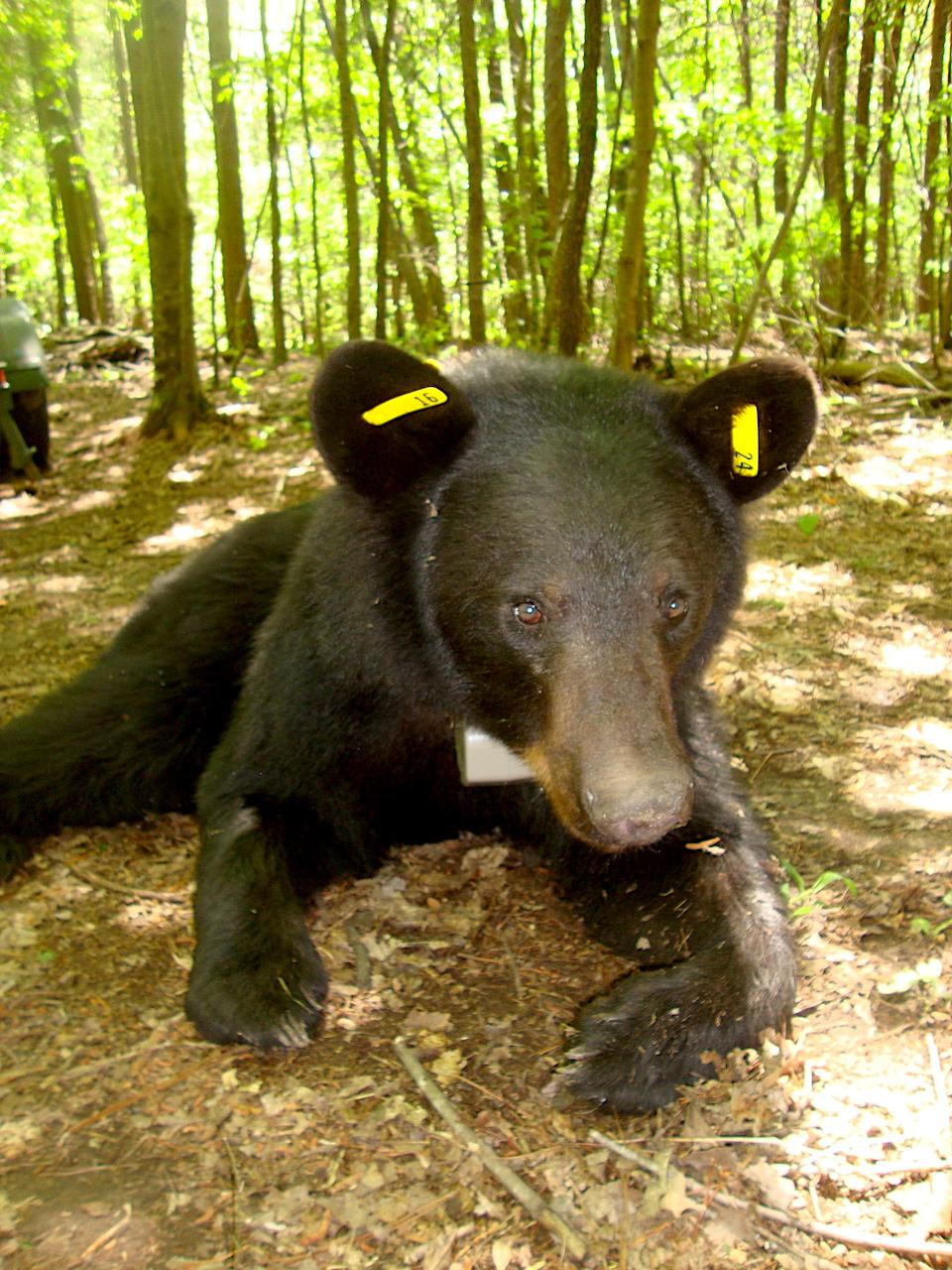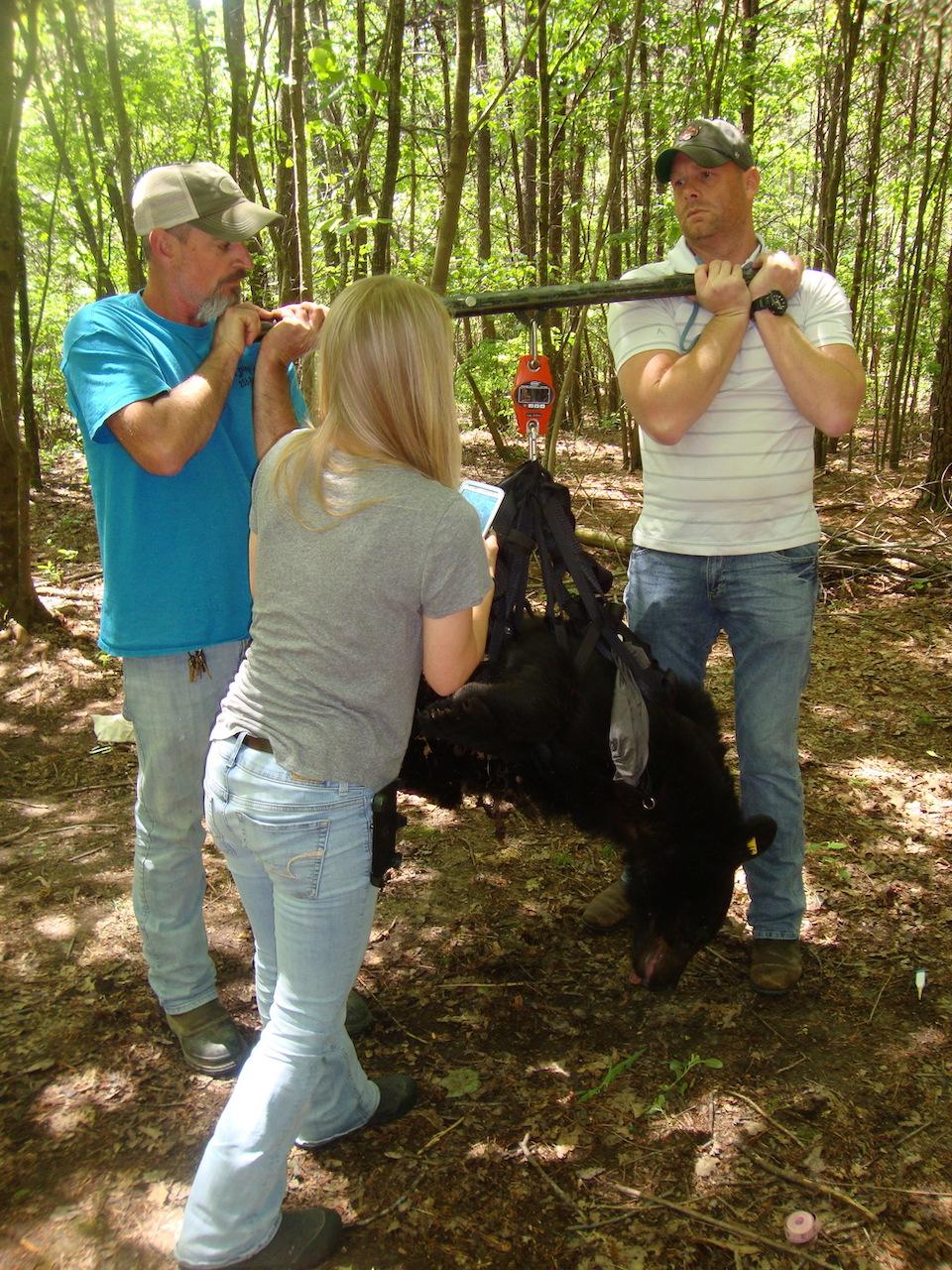
This black bear has been exploring new territory within and nearby Little River Canyon National Preserve/Jane Schneider
I expected a Grizzly Adams type when I headed to Alabama to meet the “Bear Whisperer,” but Chris Seals is lean and lanky, his Southern drawl just distinct enough to make him feel familiar to locals. Seals was here because black bears have slowly been returning to northeastern Alabama, where the 15,000 acres of Little River Canyon National Preserve run along the ridge tops, and he let me tag along when word came that one bear had stumbled into a trap.
From the Dollar Store outside Valley Head, a sleepy town 10 miles north of the park, we drive to the top of a ridgeline and then hike into an upland forest of oak, hickory, and pine. It’s early May, and bears have been active all spring on this 40-acre plat of private land. Once we arrive at the feed site, we find a young sow pacing nervously, lured into a four-by-eight-foot cage by the irresistible aroma of honey buns. Seals, an Auburn University research associate, edges closer and the sow clacks her teeth and huffs as she charges him, a bear’s way of saying “back off.”
“Hey girl, easy there,” Seals says softly, trying to distract the animal as Auburn University graduate student Hannah Leeper plunges a syringe of Telazol, a sedative, into the bear’s rump.
Here, high on craggy ridge lines in the corner of northeast Alabama, folks are seeing something that hasn’t been present in this country for more than a century: the American black bear. Little River Canyon National Preserve, located above Fort Payne, Alabama, has become home to a small but growing population of black bears. This park protects one of the Southeast’s deepest canyons as well as one of the nation’s longest mountaintop rivers. Thinly populated with farms and plenty of public parkland, the region’s rugged wilderness also provides just the right habitat for bear.

Landowner Toby Manifold (left) works with Seals (right) to help lift the sleeping
bear to be weighed. His girlfriend, Kelly Owen, records the bear's weight at 148 pounds/Jane Schneider
This keystone species has been absent regionally since the early 1900s, when bears were nearly hunted into extinction. Now one was passed out on the ground before me.
Since the bear will only be out for an hour, the team works quickly. Seals gives direction to land owners, Kelly Owen and Toby Manifold, who are on-hand this morning to assist with the data collection. (The researchers work with property owners in hopes of investing them in the bears’ health and survival.) The couple first spotted a bear on their game camera several years ago, lured in by a high-protein feed they’d been leaving out to attract white-tailed deer.
Working quickly, the biologists first record the sow’s weight, hoisting her up in a net slung from a metal rod Seals and Manifold hold above the ground from either end. “She’s right at 148.5,” Kelly reports as she reads the digital scale. Next they measure the sow’s length, stretching a tape from nose to tail. “Would you take her temperature, Toby?” Seals asks. Manifold and Owen exchange a quizzical look as he’s handed a rectal thermometer. Toby gingerly lifts a furry hind leg. “One hundred degrees,” he replies minutes later.
That’s good news, as a higher body temperature would indicate stress and put the animal in danger. To be safe, Leeper places ice packs under the bear’s front legs to keep her cool as they tag each ear. With a syringe injected into the back of the sow’s neck, a microchip the size of a rice grain is slipped under her skin and will enable biologists to identify this particular bear should her collar and tags fall off in the woods.

Little River Falls at Little River Canyon National Preserve in Alabama/Jane Schneider
Perfect Bear Habitat
The fact that bears are finding suitable habitat to establish home ranges here is of interest to Alabama’s wildlife biologists. Little River’s craggy, sandstone gorge provides thousands acres of wilderness to roam and is pockmarked with caves, the perfect habitat for denning. Bears need between three and 15 square miles as a home range, females requiring less space, males more. A bear’s diet, an omnivorous mix of berries, insects, grasses, acorns and the occasional small mammal, is also readily available.
Wade “Zibe” Lewis, facilities manager and acting superintendent for Little River Canyon, says a 2015 census indicated 25 to 30 bears in the region. Now that number ranges between 35 and 50. Todd Steury, associate professor of wildlife ecology at Auburn University, has long monitored the state’s fragmented bear population, which is estimated to be between 350 and 500 statewide. His examination of bear DNA collected from hair snares in the area determined these animals likely came north from Georgia.
“It makes sense,” Steury says, “because they’re moving along the mountains. They’re more likely to be at higher elevations because that’s where they can avoid humans and find the right habitat.”
Just how many bears this region can support is an open question. But biologists hope to learn more. They’ll be tracking the bears’ denning behavior and cub survival rate via a $1.1 million grant Steury landed from the Alabama Department of Conservation and Natural Resources. It funds a five-year study, which began in October 2018. Using radio collars — researchers will be catching and tagging a number of bears through the summer of 2019 – biologists will gain more knowledge about the bruins’ movements across this rugged land.
Bears are typically shy and elusive, which makes tracking them difficult. “It’s easier to find the dens when bears are moving and defecating, you follow the pathway,” says Steury, who uses dogs trained to recognize bear scat. Lewis admits that during his time at the park, he’s never seen a bear.

Gazing into Little River Canyon/Jane Schneider
Exploring Little River Canyon
Back in the woods, the sow has successfully been radio collared and a bright yellow tag[K1] hangs from each furry ear. The sedative almost gone, she ambles slowly back into the woods. I say goodbye to the researchers and make my way to the Little River Canyon Center, a 23,000-square-foot LEED Silver certified (Leadership for Energy and Environmental Design) visitors center.
The center is a jumping off point for travelers, providing an overview of Little River Canyon and a video that highlights its features. Roughly 500,000 people visit annually.
The Little River flows atop Lookout Mountain, meandering 23 miles from the confluence of the East and West Fork rivers near Mentone, Alabama, through the canyon before emptying into Weiss Lake south of the park. The National Park Service calls Little River Canyon “one of the most extensive canyon and gorge systems in the eastern U.S. and one of the South’s clearest, wildest waterways.” At 400 feet, it also qualifies as the deepest canyon in the Southeast.
In keeping with the rich biodiversity of the Cumberland Plateau, an elevated tableland of sandstone and shale that extends from the Kentucky border across Tennessee to northern Alabama (Little River Canyon is its southernmost extension), the preserve lays claim to a number of endangered plant species. There are glades of the federally protected green pitcher plants, a carnivorous perennial herb, and the perennial herb Harperella, also known as Bishops weed. These are among three endangered and three threatened plant species in addition to 19 endemic species unique to northern Alabama and the southern Appalachians.
The preserve was established in 1992 via a partnership between the National Park Service and Jacksonville State University. Alabama Power owned some of the land (the river had been earmarked as a possible energy source), and transferred 8,580 acres to help create the 15,288-acre park. The Park Service provides law enforcement, education outreach, and administrative services for the park, while JSU manages the facility.
Drive the scenic, 17-mile Canyon Rim Parkway and you’ll enjoy breathtaking views of the gorge. You can also fish and hike and, for thrill-seekers, kayak and rock climb.
The river that has carved this deep canyon, “is purely effected by runoff and rainfall,” notes acting-superintendent Lewis. “Rainfall is the most important factor in gauging how the river flows.”
River Views
Heavy rainfall earlier this spring has left the river higher than normal. To see it firsthand, I drive to Little Falls (off of Hwy. 35) and hike in from the trailhead. I’m enveloped by a pine-scented fragrance that’s rich and earthy as I gradually descend a path of stone steps. Finally, I arrive at the river’s edge. Here the shoreline is layered in smooth, flat sandstone slabs. I take off my sneakers to feel the sun-warmed stones beneath my feet. By contrast, the water is icy cold and swift. No swimming for me, I think. Several college students do arrive behind me clad in swimsuits, but I leave them to their folly and continue on to the boardwalk.
Atop one stone pier, I spy an eastern fence lizard sunning himself. When he sees me, he haughtily extends his bright blue belly as if to say, “Keep your distance” before scurrying off.
Once at the overlook, the view of Little Falls is spectacular. The cascading waters thunder loudly. No wonder, the swollen river tumbles down 45 feet over rocks and logs, casting veils of mist that glint in the late afternoon sun. A drive along the parkway includes several scenic pullouts. At Lynn Overlook, the thin soil of the sandstone glades offers sustenance enough for an abundance of lichen, mosses, even yucca filamentosa — referred to locally as Spanish sword — to thrive along the canyon rim.
JSU runs field schools through the center to help educate school groups from Fort Payne and beyond. “Kids come to the center to learn about science and nature. They get a first-hand experience with animals, they go hiking and leave inspired to learn more,” says center director Peter Conroy.
Conroy helped to establish the park, securing funds, in part, from NASA to build the center. The space agency has monies available for science education facilities, and their partnership continues through Little River Canyon’s Night Skies program. “It’s an unusual relationship between federal and state partners. Our goal is environmental education and economic development through sustainable tourism,” he says.
In that vein, he hopes to continue to grow the park’s visibility. Conroy is currently seeking $20-$30 million to build a 100-bed hotel and tree house village, as well as a farm-to-table restaurant, all on state property but within walking distance of the center. The aim is to host conferences “on topics related to public lands and natural resources protection,” he says. Groundbreaking could take place as early as 2020.
But don’t wait until then to discover this jewel of southern wilderness that seems a bit more wild now thanks to the arrival of bears. Its distinctive beauty is worth seeing now.
Interested in learning more about the natural world of the Cumberland Plateau? Birmingham Audubon hosts an annual, four-day workshop in Mentone, Alabama each May. At the 44th Annual Birmingham Audubon Mountain Workshop (held on the second weekend in May), you’ll find topics that include birding, hiking at Little River Canyon, plant identification, storytelling, geology, and more. • https://birminghamaudubon.org/bamw/

 Support Essential Coverage of Essential Places
Support Essential Coverage of Essential Places







Comments
Hyway 35 sounds inviting
Nice news about the bears!
Great Story. Well Written. Makes me drawn to visit the Canyon Preserve.
Thanks,
Kevin Foote
The lady has a great story. Sure had me inrested. be a greatplaceto visit if in the area.
As of March 8, 2020 there are 34 bear within in the park, according to the visitor center. Hike the area a good bit,, no sightings but I'm glad they are in the park.